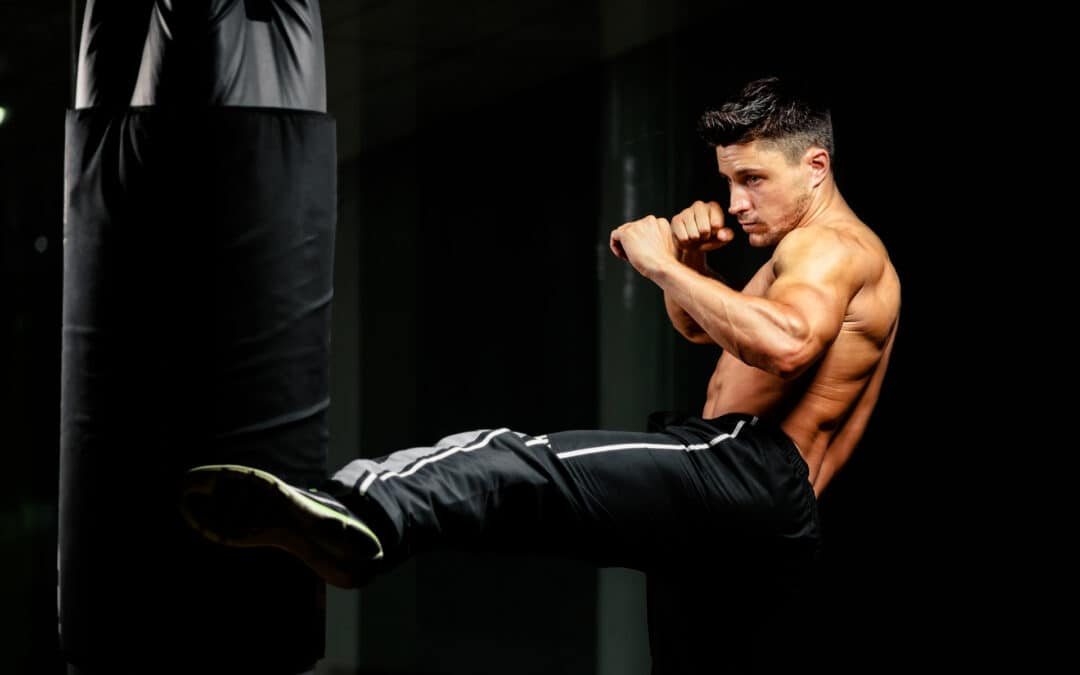Nearly every martial art that has kicks will start you off with basic kicks within the first 2 ranks. If you don’t have enough flexibility or balance, then this will be a huge wall to start off with. Don’t worry though, the more you practice correct kicking techniques, the easier it is to improve your kicking ability.
When you’re new, your instructor will just try to get you through the motions. As you improve you will learn more about what you are trying to do. This gradual instruction is usually by design, so the instructor won’t overwhelm you.
Just know that for a kick to be effective, you need to understand why a kick is a certain way and what it is designed to hit. For example, there are kicks that you can deliver to a heavy bag, and kicks you absolutely should not deliver to a heavy bag.
Table of Contents
Stance
A proper stance where you are straight and not bent over is key. What yourself in the mirror and make sure your stance is good. This will naturally help with balance.
Regardless of which leg you are kicking with, both legs are important. The supporting leg needs to be balanced, with the foot facing the correct direction. You may see that you need to improve flexibility here as well.
The kicking leg needs to have correct chambering and foot placement at the end of the kick.
You can work on your balance by standing on one leg and alternating legs. Once your balance is in a good spot, you can really drill the technique.
Footwork
Once you can deliver a kick without falling over, the next part is getting the footwork down.
At first, you start with delivering kicks from a ready position. From there you incorporate a step, whether it’s front, back, or to the side.
Once this footwork is down, you can move into sliding kicks which allow you to cover distances faster than a regular step. From here, you move into:
- Switch
- Jumping
- Spinning
- Flying/running
Even as you progress into harder kicks, one thing remains – footwork. Try practicing the steps and leadups without delivering the kick. Get used to moving your feet. You can even incorporate the cross/cover/out movements around a heavy bag to get used to moving around an opponent.
As you get used to the movements you can deliver the kicks at various times to drill the purpose of the footwork.
Flexibility
When you first learn kicks, your target will be about calf height. From there, you move towards the outside of the thigh, then ribs, and then the head.
You get to this point by stretching and repetition. Be sure to warm up to give your joints, muscles, and tendons mobility for a proper workout. This will give you the maximum full range of movement. As you build flexibility, so will the strength in your legs to be able to do the kicks properly.
Muscle tone and strength will develop as you practice. It may seem like you just aren’t built for kicks but as you stick with it, you will improve. There is no substitute for hard work.
Accuracy
This is one of the many reasons why you can’t really learn martial arts by yourself. Working with a partner or a drill with your instructor will allow you to develop focus.
Use shields, clappers, bags, or focus mitts with a partner to improve your aim. Not only can you visualize the target and shoot for it, but you also don’t want to recklessly deliver the kick and hurt your partner. It’s all connected.
Different kicks have different striking points. Learn to use the right part of your foot and be able to put it where you need to.
Power
Each kick has a purpose. Some are meant for power and some are not. However, you will be able to build the strength to do all of them as you practice.
Once you get your strength and flexibility down, your power will be able to develop as your technique is improved upon.
You will work on your chambers, being able to generate power from your hips and pull back, keeping your body centered.
It may take a few months, and maybe even years, but you will eventually be able to generate enough power to move people and bags around pretty well.
Speed
Practicing speed can sometimes be a shortcut for bad technique, which is why this section is near the end. As you begin to understand your kicks, practice them at different speeds.
Besides normal kicks, practice them slowly, like really slow. Then, practice fast kicks. This makes sure you are working through all leg muscles and will help keep you from injuring your knee or ankle.
As you improve on your speed, make them snappy. Try to get your uniform to pop when you deliver the kick, even if you aren’t kicking anything. Don’t drop your kicks either. Make sure you start and end from your chamber, even if it is from a half-chamber or transition stance.

